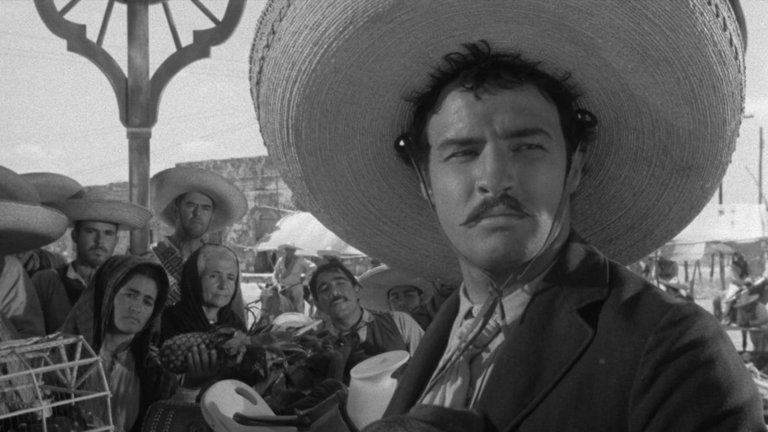
Among the two best known leaders of Mexican Revolution, Pancho Villa enjoyed much more popularity among Hollywood film makers, being more adventurous, larger-than-life and much closer to Hollywood, both figuratively and literally. Emiliano Zapata, on the other hand, operated in the remote south of Mexico and was rather dour figure, more serious about land reform and other socio-economic aspects of the revolution. When Hollywood dealt with Zapata, on the other hand, this produced an interesting result with Viva Zapata!, 1952 biopic directed by Elia Kazan.
The plot begins in 1909, in a time when Mexico has been under the rule of tyrannical President Porfirio Diaz (played by Fay Roope) for past 34 years. Delegation of poor Indian peasants from state of Morelos arrives to Mexico City in order to complain to Diaz about being deprived of their land and other injustices. One of those peasants is Emiliano Zapata (played by Marlon Brando), who stands out with his eloquence, charisma and natural leadership. When Diaz continues allowing injustices and oppression to continue, Zapata is initially reluctant to take action and instead pay more attention to attempts to live quiet life and gain sufficient wealth to marry Josefa (played by Jean Peters), daughter of rich merchant. However, one incident too many would make him take arms against government and his rebel army would join forces of Francisco Madero (played by Harold Gordon), who has is leading broad coalition of anti-Diaz forces. Rebels ultimately win, but Madero, although well-intentioned, fails to deliver land reforms Zapata’s supporters wanted and instead becomes puppet of sinister General Huerta (played by Frank Silvera) who has him deposed and ultimately kills him. Zapata again takes up arms against government and wins with the help of Pancho Villa (played by Alan Reed) enters Mexico City where he would take presidency. But he seems unhappy with new power and troubles created by his brother Mano (played by Anthony Quinn) lead him to leave office and return to Morelos where he would, for the third and last time, take arms against government.
Elia Kazan is a director who knew to get maximum effort from his cast and "Viva Zapata!" isn’t exeception. It is film that stands out for its exceptional acting, particularly the stellar performances delivered by Marlon Brando, Anthony Quinn, and the underrated Joseph Wiseman. Brando's portrayal of Emiliano Zapata, Quinn's role as Eufemio Zapata, and Wiseman in the role of fictional character of Fernando Aguirre, Zapata’s enthusiastic supporter turned into his mortal enemy, add depth and authenticity to the characters, making the film a compelling watch.
While the film excels in acting, Kazan’s direction is solid but falls short of achieving true epic status due to its black-and-white cinematography and lack of widescreen format, which only a year later, thanks to Cinemascope, became norm for Hollywood films of the similar ambition. These technical aspects somewhat hinder the film from fully realizing its potential as an epic production, despite commendable direction.
One of the significant drawbacks of Viva Zapata! lies in its writing, despite script being authored by John Steinbeck, one of the most respected American writers who actually spent huge amount of time and effort researching historical figure of Zapata. The film is poorly written, with effective episodes such as Zapata's liberation by peasants or Madero's death not being seamlessly connected into a coherent narrative.
Additionally, Elia Kazan's attempt to inject his recently anti-Communist views (and atone for his own Communist past during the height of McCarthyst hysteria) into the film are reflect in heavy-handed portrayal how power corrupts left-wing revolutionaries and turn them into into same or even worse tyrannical monsters than those they fought to replace. Kazan actually went on record by explaining that the character of Aguirre, the most sinister of them all, is based on ideologically driven but ruthless Communists he has encountered while moving in those circles. This ideological imposition detracts from the historic authenticity and Viva Zapata! often strays from historic record, including the scene that depicts Zapata serving as president of Mexico, although he never did so.
Viva Zapata!, somewhat ironically, transcended its ideological and artistic limitations, becoming an inspiration for Italian left-wing film makers who would create their very own subgenre known as “Zapata western”. Yet, although not among the best works of Elia Kazan, it still represents a good piece of cinema and could be recommended to anyone who likes top acting performances by Marlon Brando.
RATING: 6/10 (++)
Blog in Croatian https://draxblog.com
Blog in English https://draxreview.wordpress.com/
InLeo blog https://inleo.io/@drax.leo
Hiveonboard: https://hiveonboard.com?ref=drax
Rising Star game: https://www.risingstargame.com?referrer=drax
1Inch: https://1inch.exchange/#/r/0x83823d8CCB74F828148258BB4457642124b1328e
BTC donations: 1EWxiMiP6iiG9rger3NuUSd6HByaxQWafG
ETH donations: 0xB305F144323b99e6f8b1d66f5D7DE78B498C32A7
Posted using CineTV